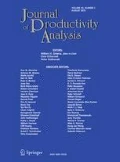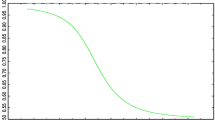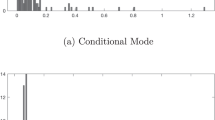Abstract
This paper proposes a tail-truncated stochastic frontier model that allows for the truncation of technical efficiency from below. The truncation bound implies the inefficiency threshold for survival. Specifically, this paper assumes a uniform distribution of technical inefficiency and derives the likelihood function. Even though this distributional assumption imposes a strong restriction that technical inefficiency has a uniform probability density over [0, θ], where θ is the threshold parameter, this model has two advantages: (1) the reduction in the number of parameters compared with more complicated tail-truncated models allows better performance in numerical optimization; and (2) it is useful for empirical studies of the distribution of efficiency or productivity, particularly the truncation of the distribution. The Monte Carlo simulation results support the argument that this model approximates the distribution of inefficiency precisely, as the data-generating process not only follows the uniform distribution but also the truncated half-normal distribution if the inefficiency threshold is small.
Similar content being viewed by others
Notes
We would like to thank one of the reviewers for pointing this out.
Greene (2008) also pointed out that \(\lambda\) gives a misleading picture of the ratio of variances in the half-normal model since \(\sigma_{u}^{2}\) is about three times larger than \(Var(u_{i} )\).
We report the estimates of \(\theta\) only for the true model, since the same \(\theta\) in the uniform distribution and the truncated half normal distribution are not the same parameter. Suppose DGP follows the uniform distribution (DGP1). THN estimates \(\theta\) that is the bound in the truncated half normal. Therefore, the differences between the estimates of \(\theta\) of THN and the true value of \(\theta\) in the uniform distribution are not informative.
According to our pilot study, we experienced stoppage in the process of numerical maximization of the logged likelihood function of THN too many times when N = 100. Thus, we failed to report the estimation performance of THN when N = 100.
References
Aigner DJ, Lovell CAK, Schmidt P (1977) Formulation and estimation of stochastic frontier production function models. J Econom 6:21–37
Almanidis P, Sickles R (2010) The skewness problem in stochastic frontier models : fact or fiction?, forthcoming in Exploring Research Frontiers in Contemporary Statistics and Econometrics: A Festschrift in Honor of Leopold Simar, Ingrid Van Keilegom and Paul Wilson (eds), Springer Publishing
Amemiya T (1973) Regression analysis when the dependent variable is truncated normal. Econometrica 41(6):997–1016
De Loecker J (2009) Product differentiation, multi-product firms and estimating the impact of trade liberalization on productivity, Working Paper, Princeton University
Dunne T, Klimek S, Schmitz JA (2008) Does Foreign competition spur productivity? evidence from Post WWII US cement manufacturing, Working Paper, Federal Reserve Bank Minneapolis
Feng Q, Horrace WC (2012) Alternative technical efficiency measures: skew, bias and scale. J Appl Econom 27:253–268
Good DH, Nadiri MI, Roller L-H, Sickles RC (1993) Efficiency and roductivity growth comparison of European and US air carriers: a first look at the data. J Prod Anal 4:115–125
Greene WH (2008) The econometric approach to efficiency analysis. In: Fried HO, Lovell CAK, Schmidt SS (eds) The measurement of productive efficiency and productivity growth. Oxford University Press, Oxford
Holmes TJ, Schmitz JA (2001) Competition at work: Railroad vs. monopoly in US shipping. Fed Reserve Bank Minneap Q Rev 19(1):3–29
Holmes TJ, Schmitz JA (2010) Competition and productivity: a review of evidence. Annu Rev Econ 2:619–642
Jondrow J, Lovell C, Materov I, Schmidt P (1982) On the estimation of technical inefficiency in the stochastic frontier production function model. J Econom 19:233–238
Lee YH (1996) Tail truncated stochastic frontier models. J Econ Theory Econom 2:137–152
Matsa D (2011) Competition and product quality in the supermarket industry. Q J Econ 126(3):1539–1591
Meeusen W, van den Broeck J (1977) Efficiency estimation from Cobb-Douglas production functions with composed error. Intern Econ Rev 18:435–555
Qian J, Sickles R (2008) Stochastic frontiers with bounded inefficiency, mimeo, Rice University
Schmidt P, Sickles R (1984) Production frontiers and panel data. J Bus Econ Stat 2(4):367–374
Stevenson RE (1980) Generalized stochastic frontier estimation. J Econom 13:57–66
Syverson C (2004) Market structure and productivity : a concrete example. J Polit Econ 112:1181–1222
Acknowledgments
Young Hoon Lee would like to acknowledge the supports by the National Research Foundation of Korea Grant funded by Korean Government (NRF-2010-330-B00069) and Sogang University Research Grant.
Author information
Authors and Affiliations
Corresponding author
Additional information
An earlier draft of this paper was based on the thesis of Sungwon Lee.
Rights and permissions
About this article
Cite this article
Lee, S., Lee, Y.H. Stochastic frontier models with threshold efficiency. J Prod Anal 42, 45–54 (2014). https://doi.org/10.1007/s11123-013-0364-9
Published:
Issue Date:
DOI: https://doi.org/10.1007/s11123-013-0364-9
Keywords
- Stochastic frontier
- Technical efficiency
- Threshold inefficiency
- Uniform distribution
- Productivity distribution




